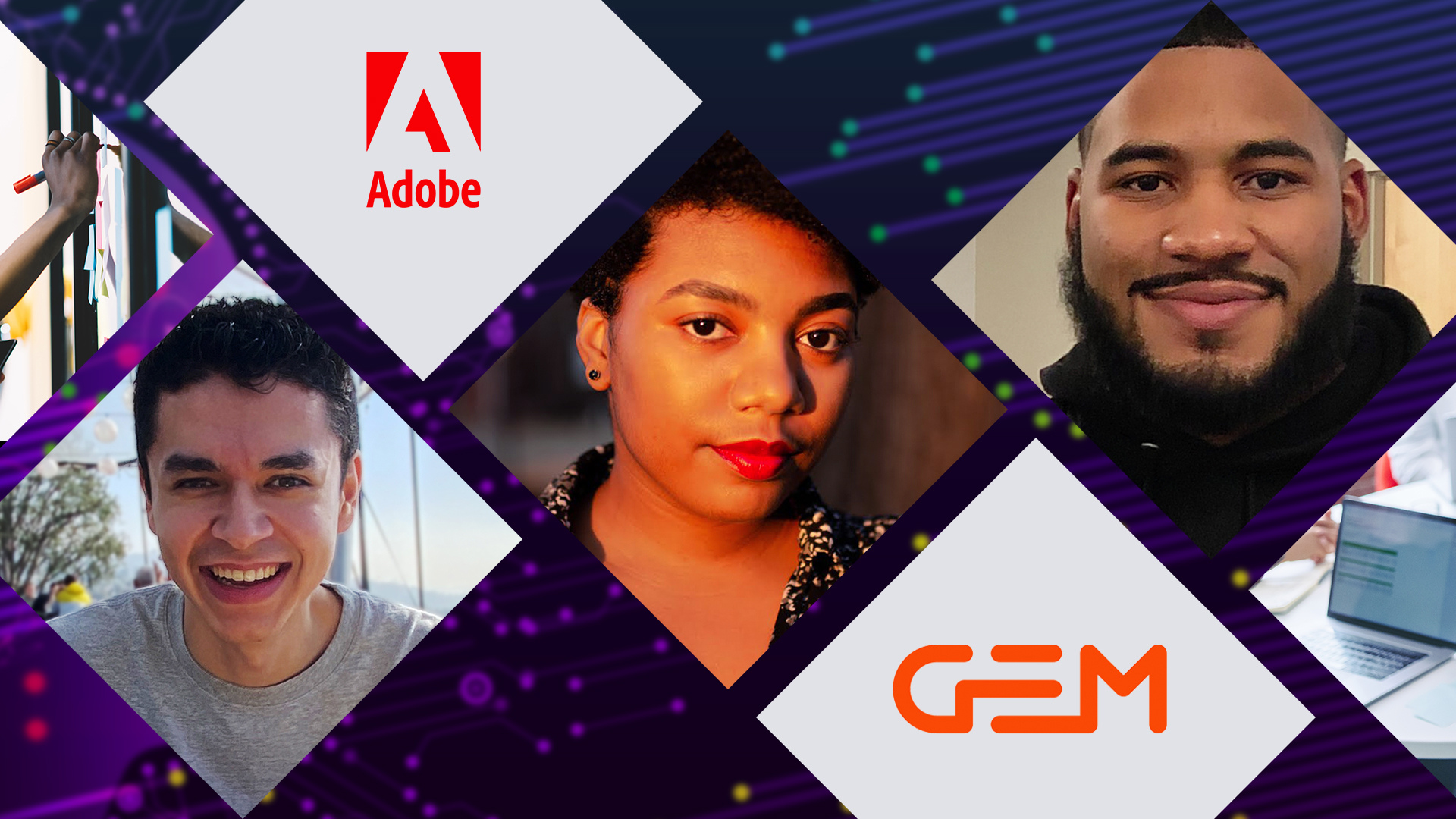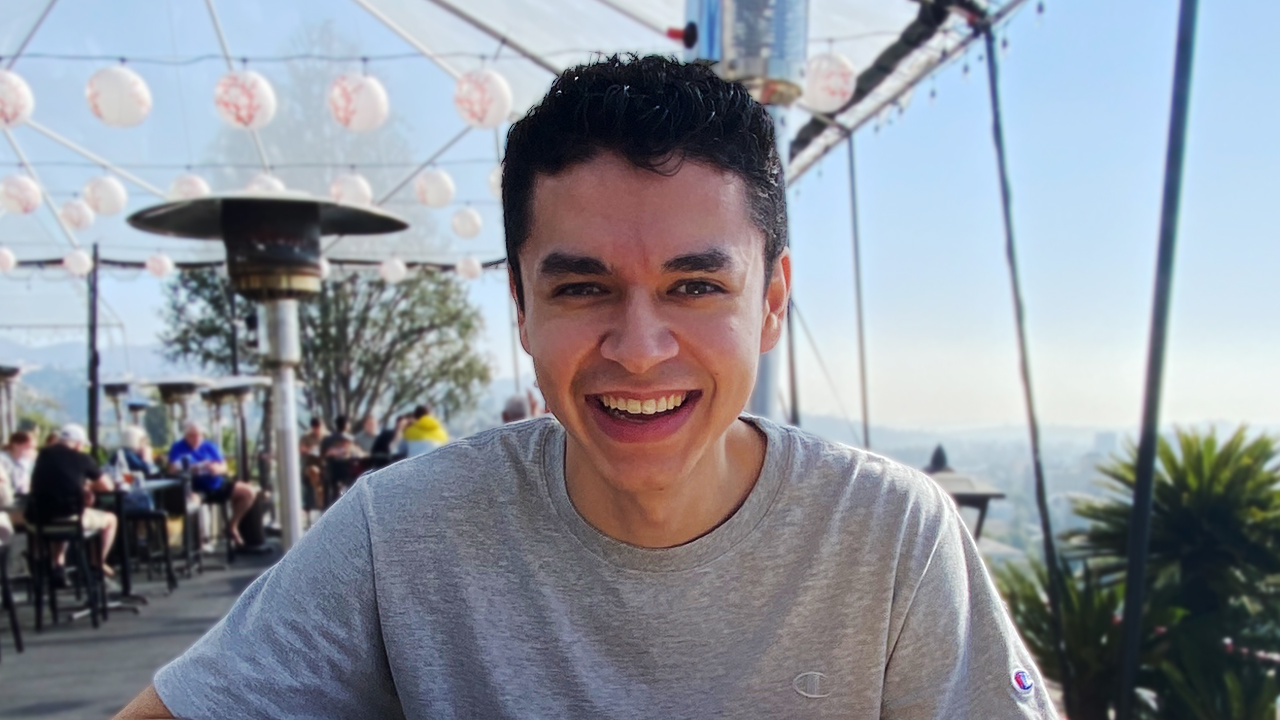
Every summer, Adobe welcomes GEM Fellows for cutting-edge STEM internships. This year, the seven GEM Fellows who interned with Adobe Research built machine learning models, trained neural networks, dug into natural language processing, and more. While each of these Fellows has unique interests and plans, they’re united in their dreams of moving STEM forward and opening doors for more STEM-minded innovators in the future.
Adobe and GEM
Adobe is a corporate sponsor of the GEM Fellowship Program through the National GEM Consortium, a network of corporations, government labs, and academic institutions that provides STEM students from underrepresented communities with financial support for graduate programs and opportunities to apply their knowledge in internships.
Since 2012, Adobe has supported more than 90 GEM Fellows and hosted over 70 GEM Fellows as interns. The 12 Adobe GEM Fellows chosen for 2022 all joined as interns at Adobe this summer. Several past GEM Fellows have returned Adobe full-time following their studies. And Adobe continues to welcome new GEM Fellows—interested students are invited to visit the GEM Fellowship Program website to learn more and apply. Applications are open until November 15, 2022.
This September, the GEM Consortium will also recognize Adobe CEO Shantanu Narayen with the GEM Corporate Leadership Award. “Adobe’s long-standing partnership with GEM is rooted in our joint mission to unleash the next generation of technical talent from underrepresented communities,” Narayen said.
How this summer’s GEM Fellows put their STEM expertise to work
This year’s Adobe Research GEM Fellows collaborated on a wide range of projects, all with exciting implications for future technology:
- Ryan Aponte worked with Senior Research Scientist Ryan Rossi to develop a machine learning model that draws on a large collection of promotional emails, websites, and posters to automatically suggest email designs to a user.
- Walter Williams worked with Research Scientists Noam Aigerman and Thibault Groueix to train a neural network for 3D mesh deformation.
- Sofia Ozambela worked with Principal Scientist John Nelson on an intuitive user interface design for video editing.
- Abel Salinas worked with Research Scientist Franck Dernoncourt to explore how natural language processing can make documents easier to understand.
- Princess Sampson worked with Research Scientist Jane Hoffswell on methods to reimagine dashboard visualizations as narrative reports.
- Ime Essien worked with Research Scientist Chang Xiao to draw data out of charts to make them more interactive.
- Carlos Taveras worked with Principal Scientist Kalyan Sunkavalli on algorithms to scan and estimate properties of materials.
We had a chance to talk to a few of the GEM Fellows to find out more about their internship experiences and their plans for the future.
A summer of natural language processing, with AI on the horizon

According to Abel Salinas, “The GEM Fellowship has been the opportunity of a lifetime. GEM has helped open my eyes to how we can apply our research to solve problems in our communities—and it has enabled me to see my research through an entrepreneurial lens. I look forward to seeing how I can apply these skills throughout my PhD.”
In fact, as long as he can remember, Salinas has been interested in using STEM to solve challenges. “Knowing how to code feels like a superpower! Too tired to make breakfast in the morning? Build a cereal vending machine that pours your milk and cereal when you wake up—that’s a real project I have worked on.”
During his research on natural language processing this summer, Salinas was excited to be up close with cutting-edge research at Adobe. “I’m grateful to be able to collaborate with great minds and to use our technical expertise to make applications better for our users,” he says.
With a bachelor’s and master’s in computer science already under his belt, Salinas will begin working on his PhD this fall at the University of Southern California, where he’ll focus on artificial intelligence.
He’s also thinking about diversity in the field, and how it ripples out into the community: “With more people from diverse backgrounds solving the world’s toughest problems, we can build solutions that reach wider audiences and bring meaningful change in underserved communities.”
Reimagining visualizations and improving tech for marginalized communities

GEM Fellow Princess Sampson grew up with entrepreneurial parents and, along the way, discovered coding through blogging and software engineering boot camps. At Spelman College, she majored in computer science and got involved with SpelBots, the university’s robotics team. That’s where she found her passion for human-centered computing.
This summer, as she worked on turning dashboard visualizations into narratives, Sampson’s goal was to improve accessibility for data storytelling. It’s all part of her goal with STEM—to make technology work well for more people.
This fall, Sampson will begin a PhD in computer science at the University of Pennsylvania. “I dream of working on projects that directly improve computing systems for marginalized communities,” she explains. “I plan to advance a world where technology deepens human connection, rather than implicitly or explicitly furthering oppression.”
Making charts more interactive and venturing into biomedical engineering
As a kid, GEM Fellow Ime Essien loved Lego, sci-fi, rocketry, and robotics, which laid the foundation for his academic pursuits. At Morgan State University, he studied electrical engineering, found his way into machine learning, and started thinking about how to change the world with technology.
This summer, Essien focused on making charts more engaging and useful. “Users will be able to click different sections of a chart to see the numbers and understand time growth. And they’ll be able to change the chart,” he explains. “I hadn’t spent as much time coding as an electrical engineering student, so doing software all summer has been interesting and a lot of fun.”
Looking ahead, Essien has big plans. ”I want to be a venture capitalist and invest in the next generation of Black founders at the intersection of machine learning and biotechnology. It’s time to diversify that industry.” He adds, “If you’re not giving everyone opportunities to start something new, you’re not helping society grow in general.”
Essien will enter the biomedical engineering PhD program at Johns Hopkins University this fall.
Estimating the properties of materials and mentoring future engineers

When you ask GEM Fellow Carlos Taveras about his favorite hobbies, math is near the top of the list. A fan since he was a kid, Taveras went on to study electrical engineering to channel his love of STEM in a practical way. Taveras first heard about the GEM Fellowship Program as a freshman at Carnegie Mellon and knew right away he was interested.
This summer was Taveras’ second internship with Adobe Research as a GEM Fellow. His project—developing algorithms to digitize real-world materials—is set to have a real impact on its future users. “Imagine a designer makes a fabric and then wants to create a virtual design with it. They can use this technology to upload the fabric so they don’t have to make real-life prototypes, which saves time and money,” Taveras explains.
Beyond the research opportunities, Taveras especially appreciates the network he’s built through the GEM Fellowship. “One of the best parts is that you meet a lot of people who are on a similar path to yours.”
This fall, he’ll enter the PhD program for electrical and computer engineering at Rice University. From there, he plans to become a professor—an idea that grew from his passion for teaching and mentoring, including a stint running the mentoring program for the CMU chapter of the National Society of Black Engineers (NSBE).
“I want to impact students and open doors that might not seem like they’re open. I think people are turned off by math because they don’t think they’ll ever use it. But there’s math in pretty much everything we interact with daily—and it allows us to describe the world in really interesting, insightful ways.”
GEM Fellowship applications are open now
Are you interested in a GEM Fellowship? Visit the GEM Fellowship Program website to learn more and apply. Applications are open until November 15, 2022.